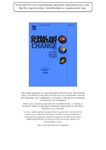Palaeolimnological evidence for an east–west climate see-saw in the Mediterranean since AD 900
| dc.contributor.author | Roberts, C Neil | |
| dc.contributor.author | Moreno, A | |
| dc.contributor.author | Valero-Garcés, BL | |
| dc.contributor.author | Corella, JP | |
| dc.contributor.author | Jones, M | |
| dc.contributor.author | Allcock, S | |
| dc.contributor.author | Woodbridge, Jessie | |
| dc.contributor.author | Morellón, M | |
| dc.contributor.author | Luterbacher, J | |
| dc.contributor.author | Xoplaki, E | |
| dc.contributor.author | Türkeş, M | |
| dc.date.accessioned | 2014-11-10T14:59:39Z | |
| dc.date.available | 2014-11-10T14:59:39Z | |
| dc.date.issued | 2012-03 | |
| dc.identifier.issn | 0921-8181 | |
| dc.identifier.issn | 1872-6364 | |
| dc.identifier.uri | http://hdl.handle.net/10026.1/3159 | |
| dc.description.abstract |
During the period of instrumental records, the North Atlantic Oscillation (NAO) has strongly influenced inter-annual precipitation variations in the western Mediterranean, while some eastern parts of the basin have shown an anti-phase relationship in precipitation and atmospheric pressure. Here we explore how the NAO and other atmospheric circulation modes operated over the longer timescales of the Medieval Climate Anomaly (MCA) and Little Ice Age (LIA). High-resolution palaeolimnological evidence from opposite ends of the Mediterranean basin, supplemented by other palaeoclimate data, is used to track shifts in regional hydro-climatic conditions. Multiple geochemical, sedimentological, isotopic and palaeoecological proxies from Estanya and Montcortés lakes in northeast Spain and Nar lake in central Turkey have been cross-correlated at decadal time intervals since AD 900. These dryland lakes capture sensitively changes in precipitation/evaporation (P/E) balance by adjustments in water level and salinity, and are especially valuable for reconstructing variability over decadal-centennial timescales. Iberian lakes show lower water levels and higher salinities during the 11th to 13th centuries synchronous with the MCA and generally more humid conditions during the 'LIA' (15th-19th centuries). This pattern is also clearly evident in tree-ring records from Morocco and from marine cores in the western Mediterranean Sea. In the eastern Mediterranean, palaeoclimatic records from Turkey, Greece and the Levant show generally drier hydro-climatic conditions during the LIA and a wetter phase during the MCA. This implies that a bipolar climate see-saw has operated in the Mediterranean for the last 1100. years. However, while western Mediterranean aridity appears consistent with persistent positive NAO state during the MCA, the pattern is less clear in the eastern Mediterranean. Here the strongest evidence for higher winter season precipitation during the MCA comes from central Turkey in the northeastern sector of the Mediterranean basin. This in turn implies that the LIA/MCA hydro-climatic pattern in the Mediterranean was determined by a combination of different climate modes along with major physical geographical controls, and not by NAO forcing alone, or that the character of the NAO and its teleconnections have been non-stationary. © 2011 Elsevier B.V. | |
| dc.format.extent | 23-34 | |
| dc.language | en | |
| dc.language.iso | en | |
| dc.publisher | Elsevier BV | |
| dc.subject | Mediterranean | |
| dc.subject | Medieval Climate Anomaly | |
| dc.subject | Little Ice Age | |
| dc.subject | palaeolimnology | |
| dc.subject | North Atlantic Oscillation | |
| dc.subject | teleconnection patterns | |
| dc.title | Palaeolimnological evidence for an east–west climate see-saw in the Mediterranean since AD 900 | |
| dc.type | journal-article | |
| dc.type | Journal Article | |
| plymouth.author-url | https://www.webofscience.com/api/gateway?GWVersion=2&SrcApp=PARTNER_APP&SrcAuth=LinksAMR&KeyUT=WOS:000301750700005&DestLinkType=FullRecord&DestApp=ALL_WOS&UsrCustomerID=11bb513d99f797142bcfeffcc58ea008 | |
| plymouth.volume | 84-85 | |
| plymouth.publication-status | Published | |
| plymouth.journal | Global and Planetary Change | |
| dc.identifier.doi | 10.1016/j.gloplacha.2011.11.002 | |
| plymouth.organisational-group | /Plymouth | |
| plymouth.organisational-group | /Plymouth/Faculty of Science and Engineering | |
| plymouth.organisational-group | /Plymouth/Faculty of Science and Engineering/School of Geography, Earth and Environmental Sciences | |
| plymouth.organisational-group | /Plymouth/REF 2021 Researchers by UoA | |
| plymouth.organisational-group | /Plymouth/REF 2021 Researchers by UoA/UoA14 Geography and Environmental Studies | |
| plymouth.organisational-group | /Plymouth/Research Groups | |
| plymouth.organisational-group | /Plymouth/Research Groups/Centre for Research in Environment and Society (CeRES) | |
| plymouth.organisational-group | /Plymouth/Research Groups/Centre for Research in Environment and Society (CeRES)/CeRES (Reporting) | |
| plymouth.organisational-group | /Plymouth/Research Groups/Marine Institute | |
| plymouth.organisational-group | /Plymouth/Users by role | |
| plymouth.organisational-group | /Plymouth/Users by role/Academics | |
| dc.identifier.eissn | 1872-6364 | |
| dc.rights.embargoperiod | Not known | |
| rioxxterms.versionofrecord | 10.1016/j.gloplacha.2011.11.002 | |
| rioxxterms.licenseref.uri | http://www.rioxx.net/licenses/all-rights-reserved | |
| rioxxterms.type | Journal Article/Review |


